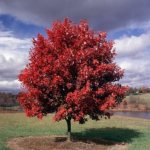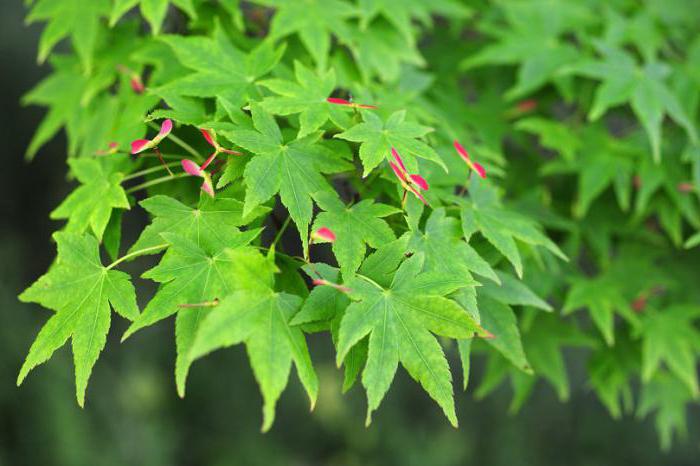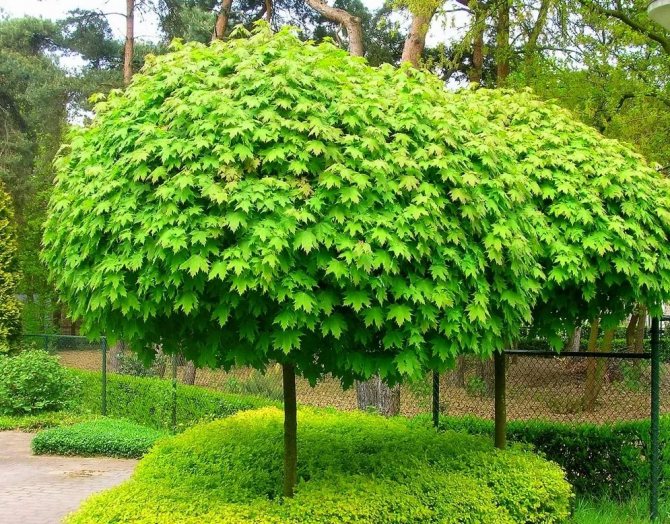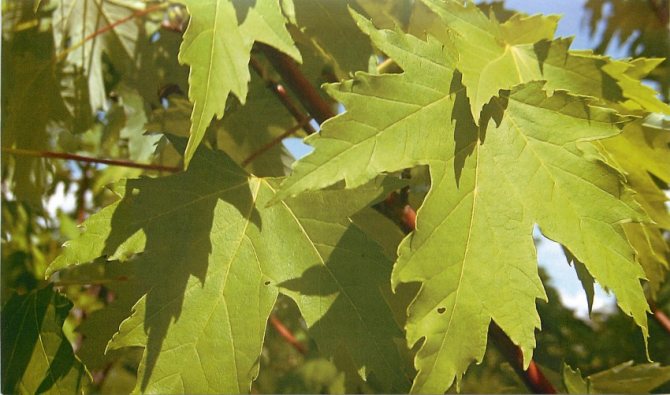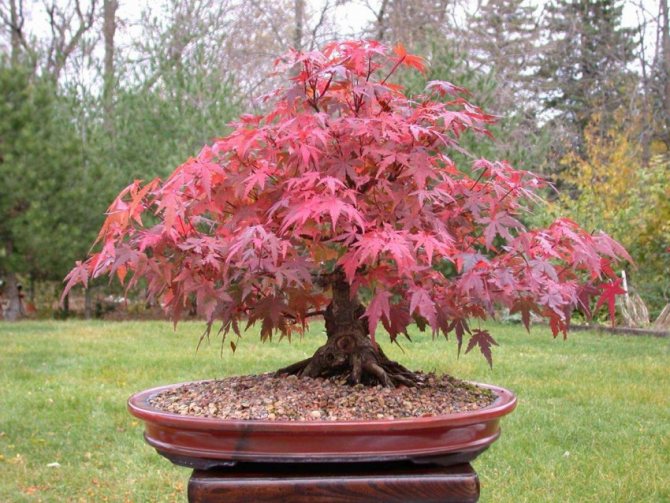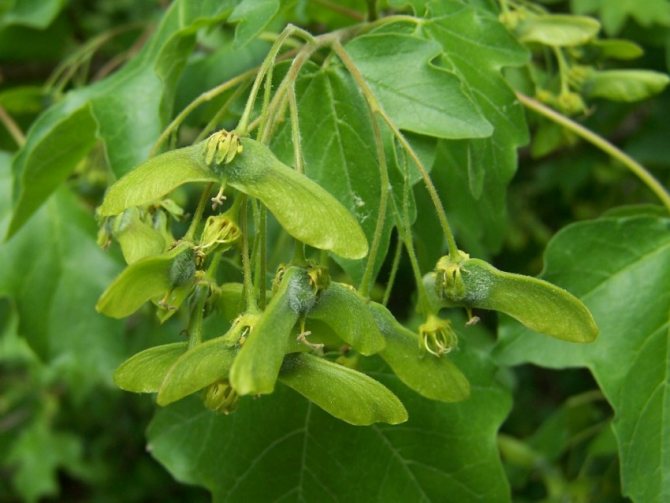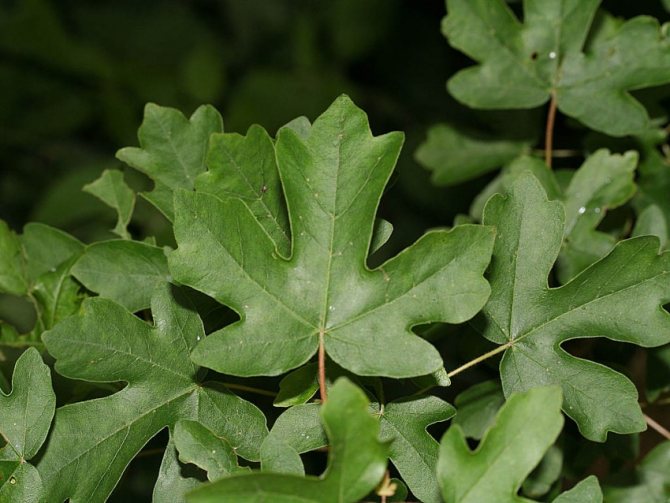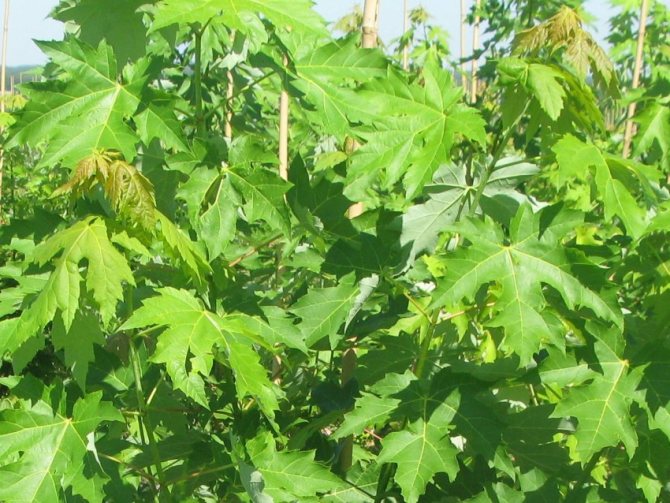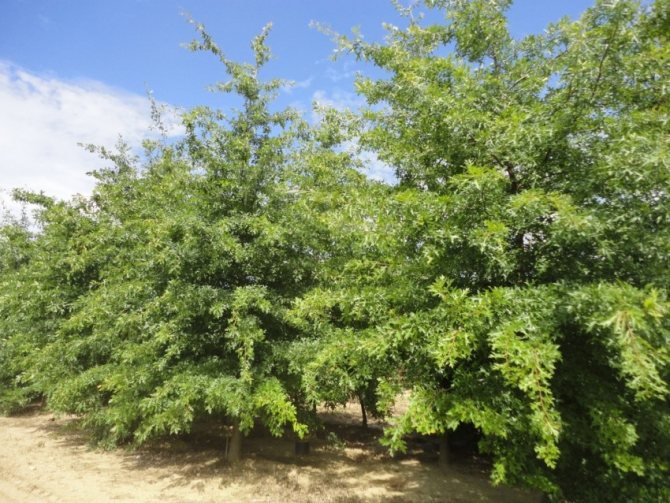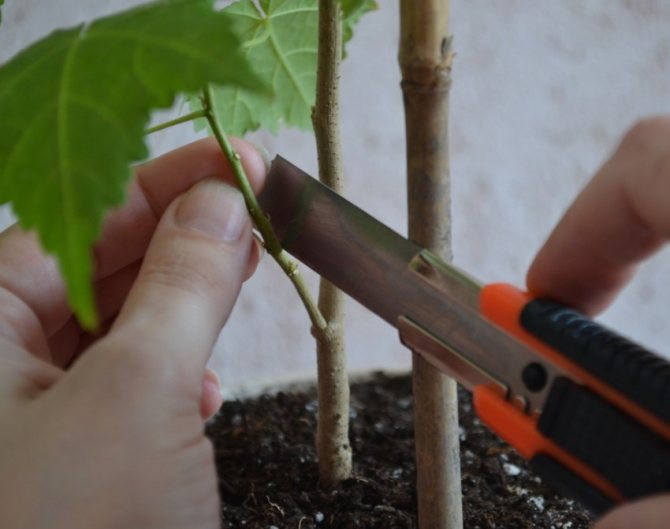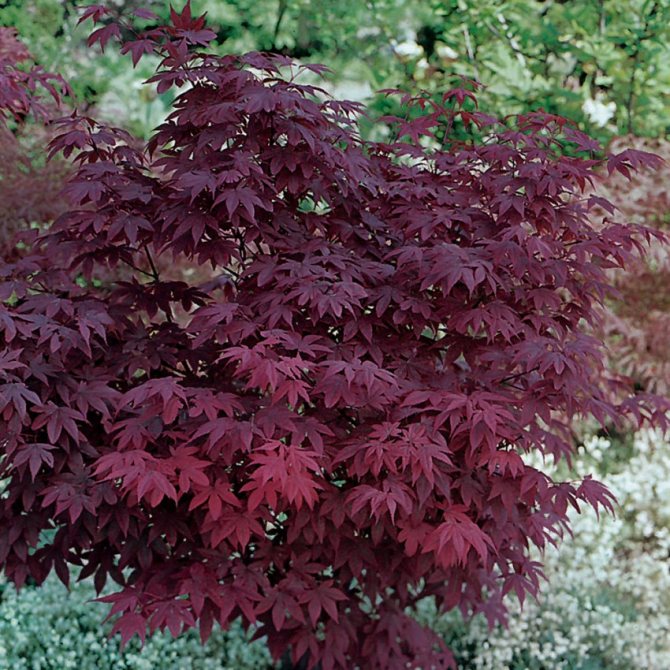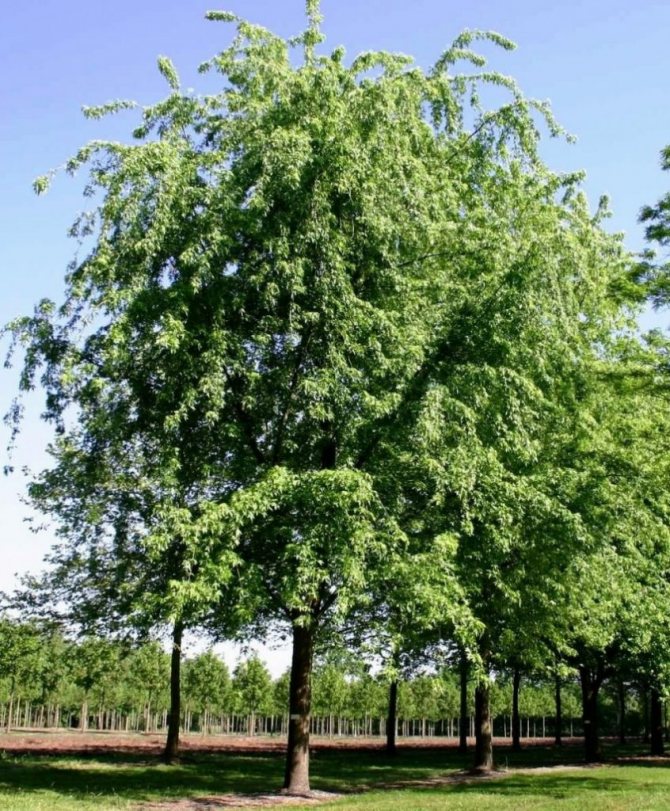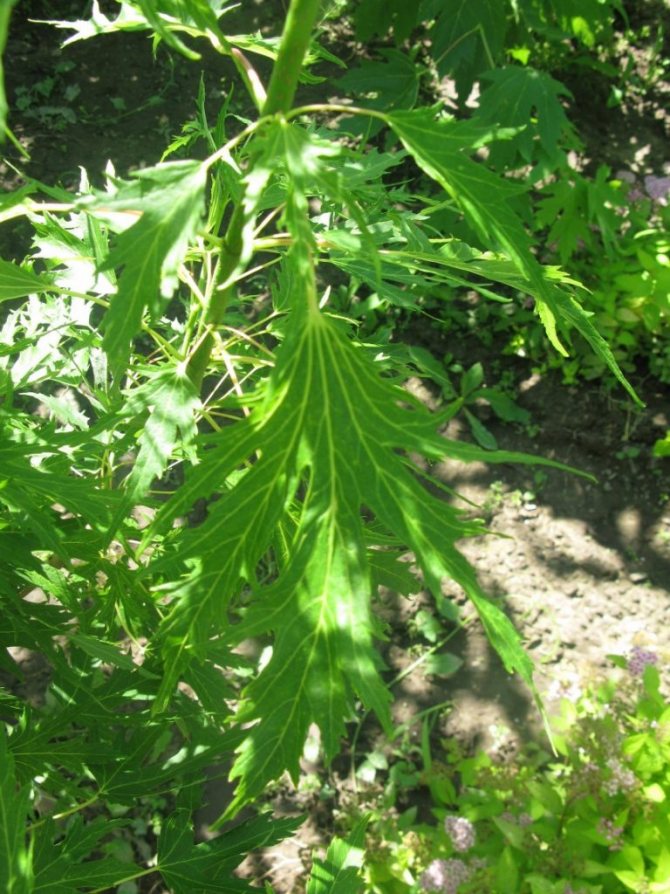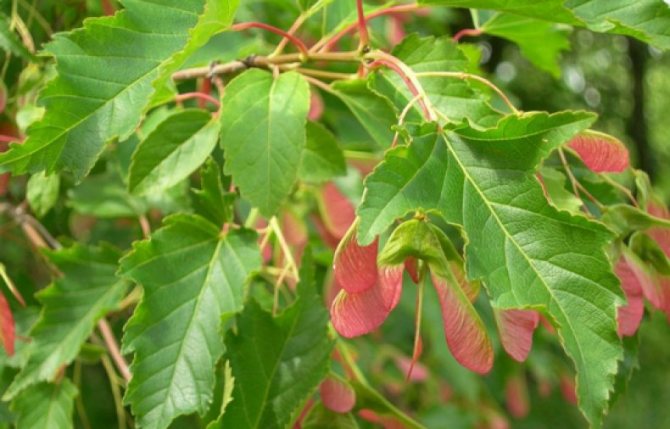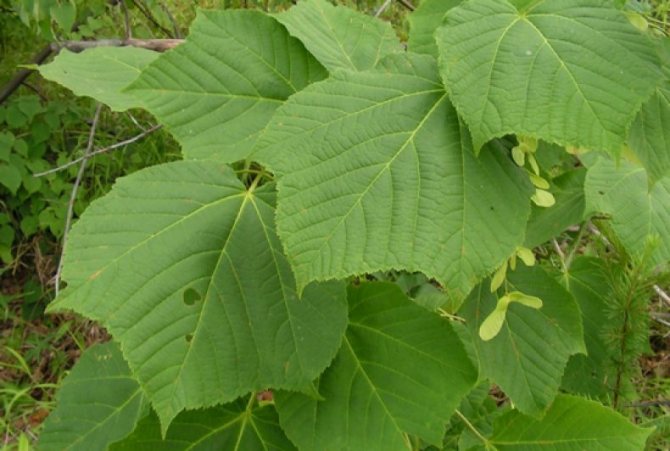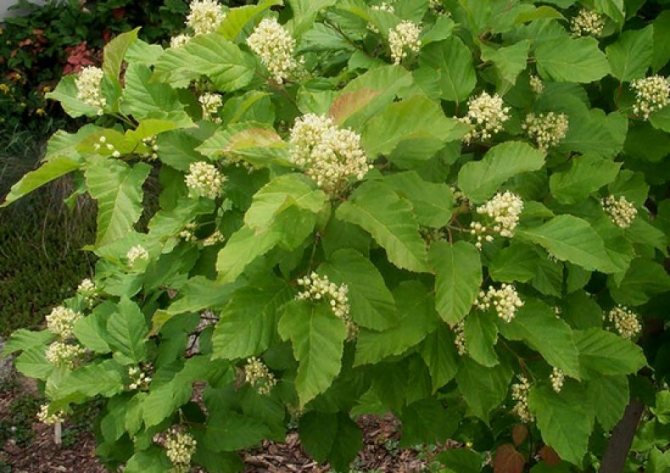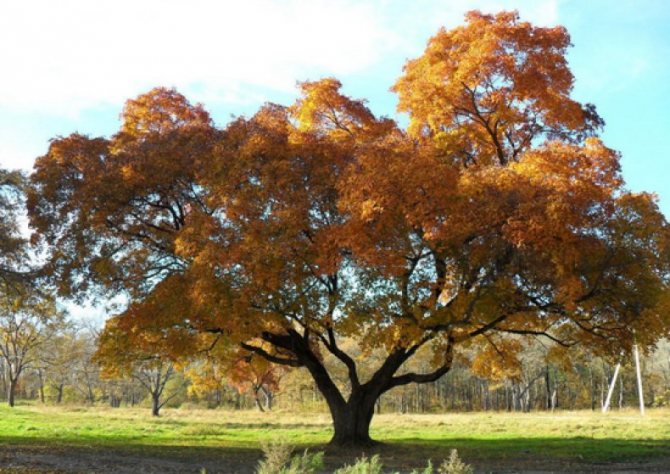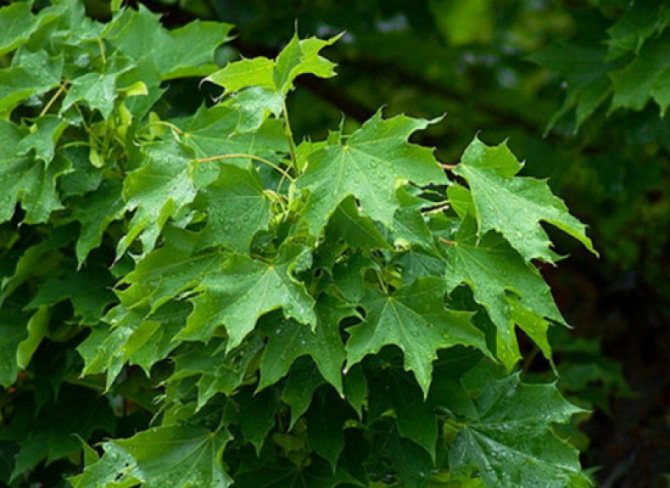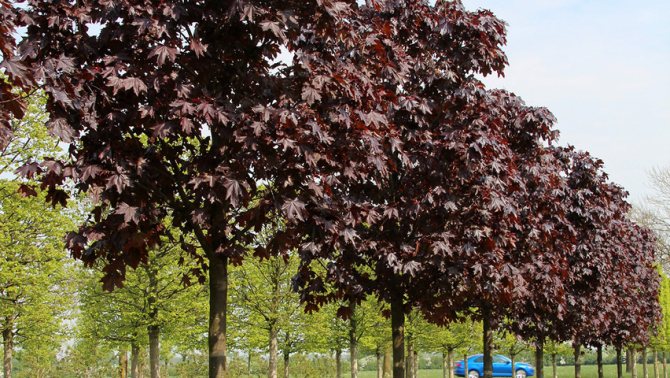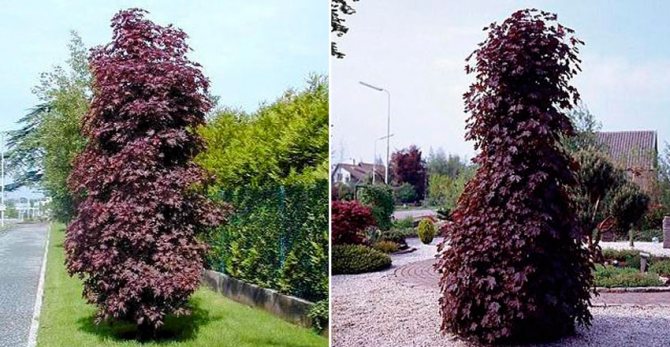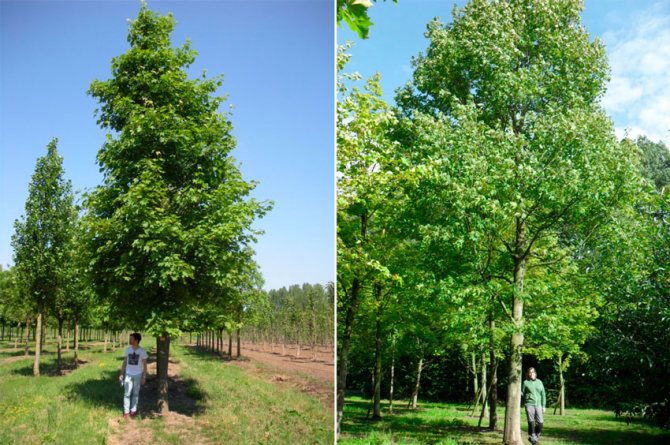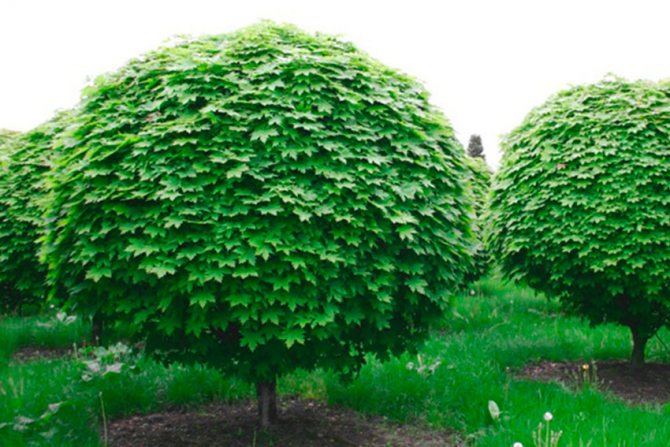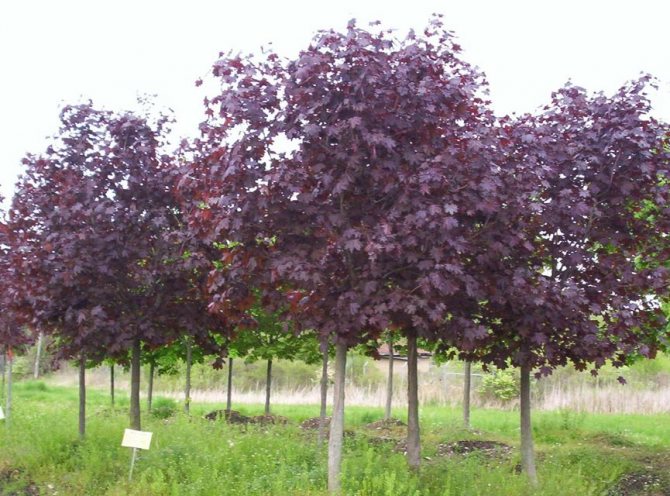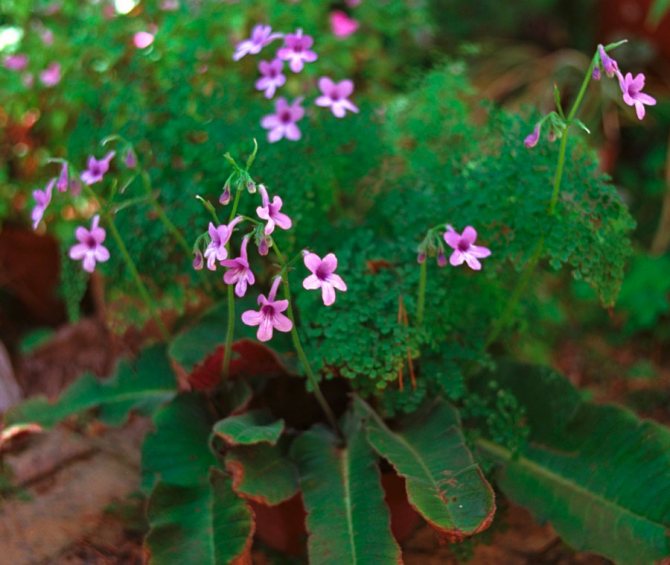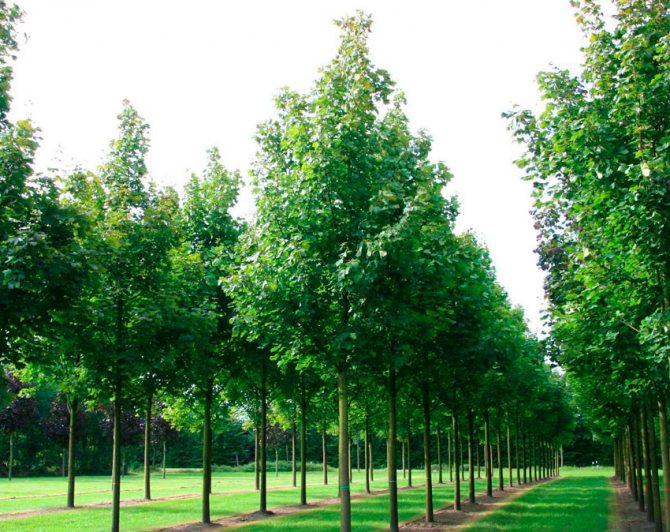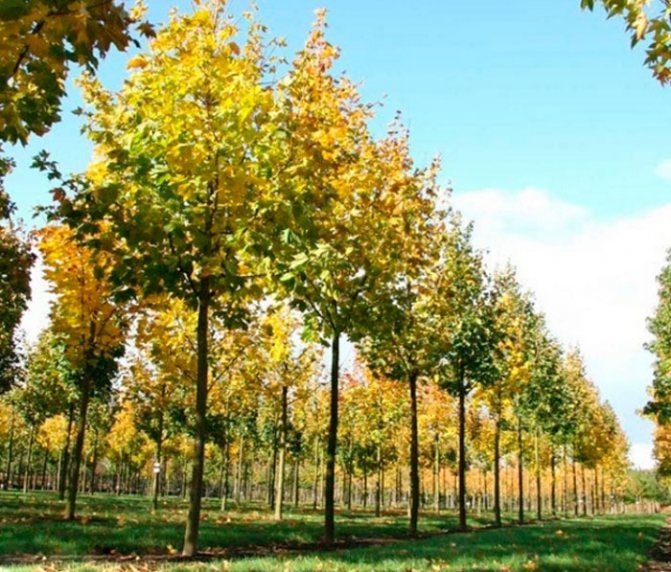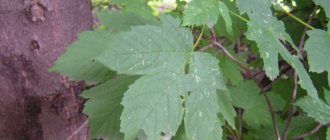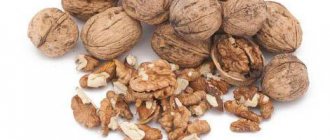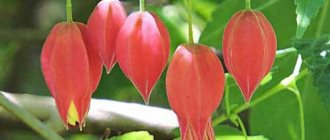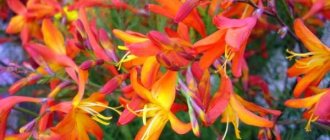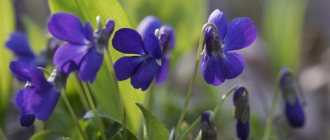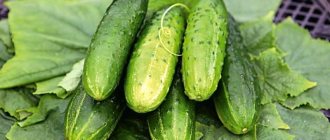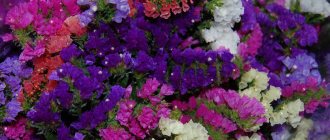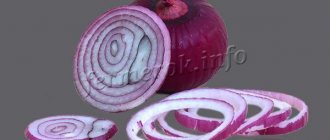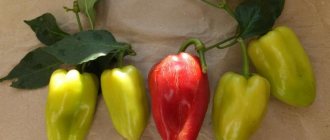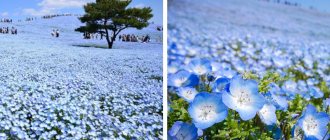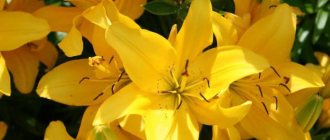The height of the plant, if it has a tree-like shape, varies within 10–40 meters, but if the maple grows like a shrub, the branches of which originate from the base of the stem, then its height indicators will reach 5–10 meters. Most of the species are deciduous representatives of the flora, but only a few species that grow in the territory of South Asia and the Mediterranean never lose their deciduous mass - they are evergreen.
Basically, the leaf plates are located opposite on the branches, and in a large number of members of the family they are palm-shaped (that is, they have a finger-like shape). On each of the blades, you can count from three to nine veins, with the obligatory central one. And only in some varieties of maples, the leaves have a complex-palmate shape, and also complex-pinnate, with feathery venation, or generally devoid of lobes can be found.
When the plant blooms, buds are formed, which differ in five symmetrically placed petals. From such flowers, racemose, corymbose or umbellate inflorescences are collected. The flower contains five sepals and the same number of petals, the length of which varies from 1 to 6 mm. Inside there are 12 stamens of 6–10 mm each, a pair of pistils of various types. The ovary has a higher location and has a pair of carpels. It is their wings that will then begin to stretch out of the flower, and make it clear what gender the flower is - with them it is female. The flowering process in maples occurs at the end of winter or early spring, but most of the varieties begin to produce flowers after the appearance of leaves, and in some they are formed before them.
The color of the flowers is varied, there is a green, yellowish, orange or red hue. Their size is very small, but there are so many of them that from a distance it seems as if the whole tree is covered with flowers. The nectary has a flat ring shape and is located between the petals and stamens. In the Norway maple variety, this formation extends to the ovary itself and the stamens are immersed in it with their bases.
When fruiting, a fruit, called a two-winged fruit, ripens, it is made up of a pair of identical parts, and when, ripening, it falls off, then rotation begins. In this case, the seed is carried away at a considerable distance from the parent tree.The fruit ripens after flowering for 2–6 weeks. Maple is a rather unpretentious plant and even a novice gardener can cope with its cultivation.
Japanese maple
Japanese maple (Acer japonicum thumb, fan, red) is a deciduous perennial plant that began to be grown in Japan. In total, there are more than a hundred species of maple. The 11-lobed leaves of this tree are bright green in summer, and in autumn they turn into purple tones of extraordinary beauty. Once you see this sight, you will not be able to resist the Japanese maple. Therefore, it is reasonable to want to grow this plant in your personal plot. Since such a tree is not widespread in our latitudes, for its successful growth you need to know how to care for the Japanese maple.
Japanese maple: care and cultivation in the garden
If you do decide to buy a Japanese maple, then planting and caring for it requires careful preparation. Indeed, its future depends on the correct planting of a plant: will it take root, will its leaves have the same bright color as it should be.
Maple will feel best in partial shade. If it is in direct sunlight, the leaves may get burned.
Sour garden soil is used for its cultivation.
For a tree to grow strong and hardy, you need to fertilize the soil once a month in the spring and summer. In winter, feeding is not carried out.
Maple is very picky about watering. If this is a young plant, then it needs not only to be watered more often, but also to provide a sufficiently large volume of water. In the summer, the tree is watered once a week, in the cold season - once a month. After each watering, you need to remove weeds and loosen the soil to a shallow depth. This will avoid sealing the seat. If the soil is dry, maple will develop very slowly.
How to Grow Japanese Maple from Seeds?
If you want to grow a maple from seeds, then you first need to decide on the type of maple, since not all of its varieties are propagated by seeds, some by grafting or cuttings. The following types of maple are suitable for growing maple from seeds:
- Tatar;
- Ginnala;
- green-barked;
- holly.
Seeds begin to fall off in the fall, then they need to be collected. First, the seeds are stratified: for at least 120 days they are kept in a cold room, where the ambient temperature does not exceed five degrees. The best storage place is a regular refrigerator. The seeds are placed in a container with sand, which must be slightly moistened.
In April-May, you can start planting germinated seeds. To make sprouts appear faster, maple seeds are soaked in hydrogen peroxide for 1-3 days. The seeds are then ready to be planted directly in the open field. Before planting, peat, sand and humus must first be added to the garden soil.
Maple seeds should be planted at least three centimeters deep. If in the future you do not plan to replant seedlings, then the minimum distance between seeds should be at least 1.5 meters. After planting, the seeds are watered. The soil must be constantly kept moist.
After planting the seeds, the first shoots can be observed no earlier than two weeks later. It should be remembered that maple grows quite slowly and you need to be patient before the shoots become like a tree. During the growth period, caring for Japanese maple is quite simple:
- watering;
- weed removal;
- weeding the soil.
With proper care in the fall, plant height can reach 20-40 cm.
Japanese maple is planted in a permanent location after 1-3 years. Pre-dig a hole 50 cm wide and 70 cm deep. The soil should be the same as when germinating seeds.Additionally, add humus or compost. Every year in the summer, fertilizer is applied to the soil for perennial plants.
The Japanese maple is an unusually beautiful plant that, if properly cared for, can delight the eyes of others.
Home comfort
Planting and caring for a red maple
These trees with red leaves look very beautiful in both single and limited group plantings. When planting, it is necessary to maintain a distance between seedlings from one and a half to three and a half meters. A landing pit is prepared with a depth of fifty to seventy centimeters. In case of planting in a wetland area, be sure to think about good drainage. When planting, the hole must be half filled with water and complex fertilizers must be added to the soil.
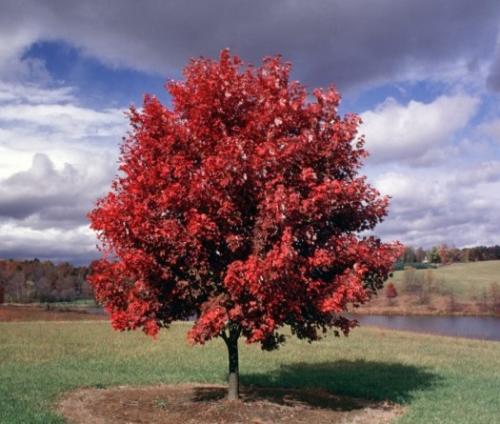
Lonely handsome man
Some varieties of red maple are specially bred by breeders for growing in tubs or containers. These plants do not exceed one and a half meters in height. Maple is planted in clay or plastic pots in lush, humus-rich soil made from equal parts compost, turf and peat. A plant grown in pots does not like excessive waterlogging of the soil. Watering red maples, and those that grow in tubs and those growing in the open field, must be combined with fertilization. The frequency of watering depends on the growing area and the weather. With a lack of watering, plantings of red maple survive, but lose their decorative effect.
When caring for red maple, pruning is essential. Maple does not require radical pruning, it is enough to cut damaged and dry branches in a timely manner. It is also necessary to seal the environment and damage on the bark in a timely manner with the help of a garden varnish in order to protect the tree from pests and diseases. But this garden plant acquires a special decorative effect, having been in the hands, or rather in the scissors, of a skilled gardener. Trees, thanks to shearing, acquire truly fantastic shapes, and in combination with the color of the foliage, this creates a fabulously beautiful result.
You are my curly maple!
In its varieties, maple, repeatedly sung by poets and captured by painters, is diverse, therefore, if you want to decorate a garden plot with such an original tree, there is always the opportunity to choose the most suitable variety. I am especially proud of a specimen grown with my own hands from seeds; moreover, this process is not particularly difficult and even a beginner can do it. How to grow maple from seeds at home? One has only to take into account that several varieties can grow from seeds: holly, Ginnala, green-brown and Tatar. The rest of the varieties are propagated by grafting or cuttings.
What are the ways to grow seeds?
Cold stratification method
In this way, many types of maple are grown from seeds. These include maples:
- American
- Japanese
- Norwegian
- large-leaved
- sugar.
Seeds are picked up that are not spoiled and not rotten, but dried up are pre-soaked.
Thanks to this method, the seeds germinate quickly enough. For seeds, you will need a small plastic bag filled with growing material consisting of sand, peat moss or vermiculite or paper. To prevent fungus, it is advisable to have a sterile material. For moistening, a little water is added to the sowing mixture. And for the prevention of mold, you need to add just a little fungicide.
Next, the seeds are packed in 25 pieces in a bag, which is tedious to iron with a palm to remove air and close with a fastener. The bags are placed in the refrigerator, where they are kept at a temperature of 1 to 4 degrees Celsius, which promotes germination.Some species are quite picky and a temperature difference of a couple of degrees will negatively affect the growth of seeds, For example, the American maple seed feels comfortable at +5 degrees, and +3 degrees is enough for red maple seeds.
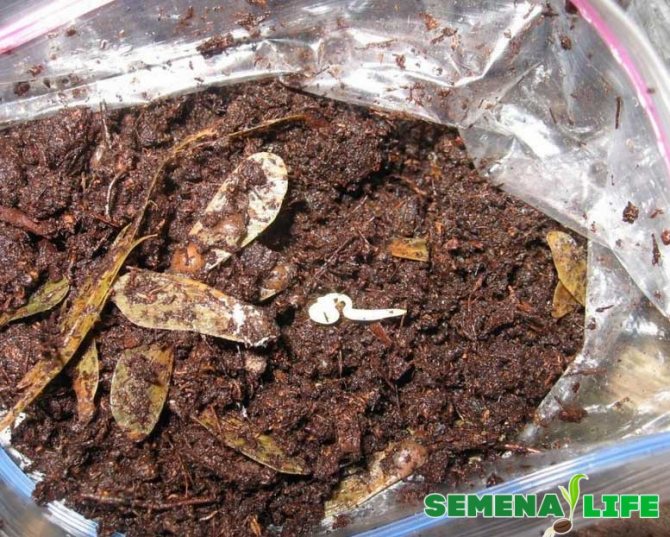

Most types of seeds are in the refrigerator for 3-4 months, but 40 days is enough for large-leaved maple. Every fourteen days, the bags should be checked for excess or lack of moisture, mold, etc. When growth begins, the seeds are removed from the refrigerator. Sprouted seeds are planted in moist soil to a depth of 1.5 cm. To ensure that the sprout takes root, the seeds can be planted for a while in a tray.
Cold and warm stratification method
This method is well suited for mountainous and Asian species with a very hard shell that needs treatment in the form of an incision, soaking in peroxide, in warm water. For two months, the seeds are stored at a temperature of 20 to 30 degrees. Further, the seeds are subjected to the above-described cold stratification method.
Growing maple seeds directly in the soil
In some species of maples, for example, silver maples, seed discharge occurs at the beginning of the growing season. These seeds do not hibernate, they do not need additional care. You need to plant the seeds almost after harvesting and they will germinate quickly. Planting consists in placing the seeds in moist soil mixed with fallen leaves without additional maintenance.
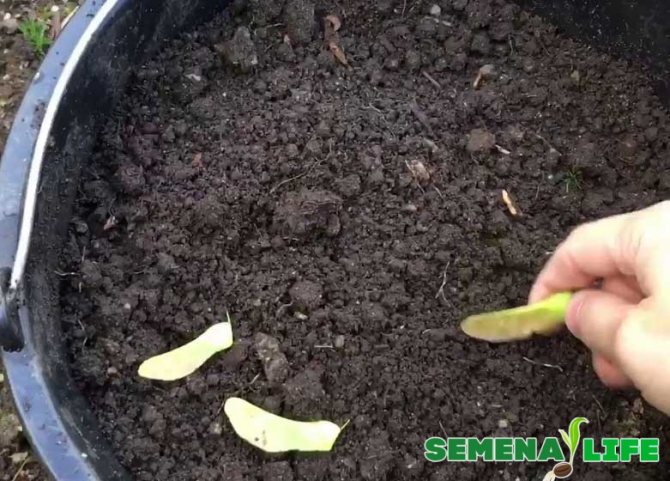

Some seeds may not grow in the first year of planting, and will germinate only the next. When a small percentage of seeds germinate, there is a chance that they have been spoiled. In this case, it is advisable to plant new ones.
Maple grown from seed can grow up to 30 meters in height.
Having decided on the desired type of maple, we purchase or find and collect seeds ourselves, now it will not be difficult for you to grow a maple from seeds at home. Fortunately, in our country there is a large selection of varieties of this fabulous tree.
Description of maple seeds
Maple seeds ripen in August and fall off in autumn (but not always, they can hang from the tree for a long period). Therefore, it is easy enough to find them in the heap of fallen leaves under the trees. In order to detect future planting material, you need to understand what maple seeds look like. Outwardly, they are a flat double lionfish with two wings. The fruit consists of 2 parts, each of which contains one seed: naked, with a large green embryo. Fruiting of this luxurious tree, characterized by wind resistance due to its strong root system, is abundant and occurs annually.
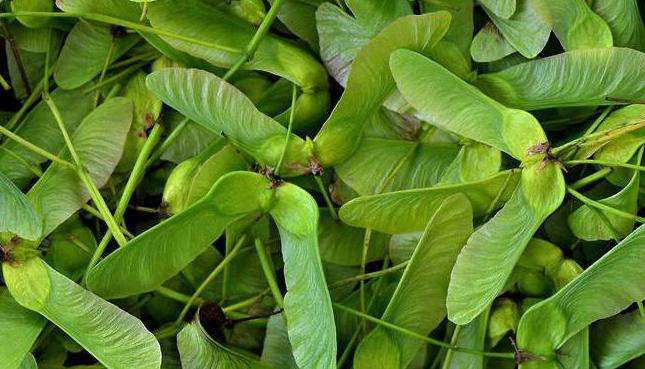

By the way, in the genus of maple, there are more than 150 varieties that grow in different parts of the planet and originate mostly from North America. Some of them are found even in the Northern Hemisphere and the tropics. The most valuable maple is sugar maple, it is found in the Great Lakes region and in Eastern Canada.
Maple Ginnala transplant. Description of appearance
In autumn, this culture adorns the garden with its beautiful foliage. Maple ginalla (in other words - riverine) comes from the genus of the same name and the Sapindov family. Such a shrub does not differ in height and changes foliage every year. The height of the tree can vary from 3 to 8 meters. The crown is spreading, wide, has the shape of a tent. The crown can be up to seven meters in diameter.
The bark is small in thickness, represented by a brown color with a gray tint. In older crops, the bark is usually cracked. The branches are thin and erect, colored brown and red.
The root system is of a superficial type with abundant density. The leaves are arranged oppositely, reaching a length of 10 centimeters, a width of about five. All leaves are divided into three separate lobes, the middle lobe is elongated.Over time, the section begins to become less noticeable. The leaves grow on straight petioles with a total length of up to five centimeters, very often pink in color. The surface is smooth, dark green.
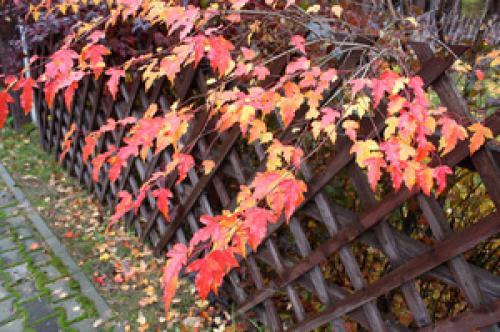

Maple inflorescences form in spring, when the leaves are fully developed. The flowers are yellow-green. Average sizes in diameter can be up to 0.8 centimeters. The inflorescences create solid panicle brushes and exude a pleasant scent. The flowering process lasts two to three weeks.
At the end of summer, paired lionfish appear on the tree, which subsequently form fruits. Their length reaches a centimeter and a width of up to five centimeters. At first, the fruits are red, over time they begin to become dark.
The growth rate of the tree is moderate. In one year, from 30 to 50 centimeters are added, everything will depend on the growing conditions of the crop. The life time of this tree is long. The culture can grow for about 100 years, but trees have been noted that have continued to grow for 250 years.
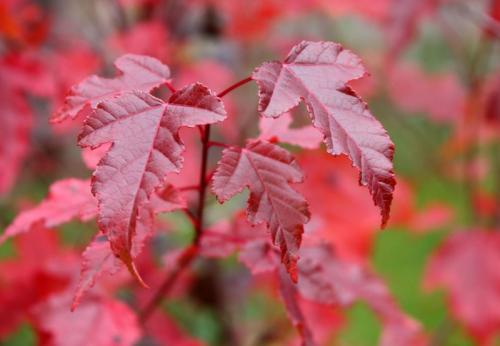

The maple leaf has been used by the inhabitants of Canada as a state symbol since the 17th century. Since 1965, it has been used on the official flag of the state. Such an honor was given to the plant due to the fact that sugar maples are important economic resources of the country, they are used during logging, in the extraction of sugar, as well as for the preparation of nutritious maple syrup, which helps to improve human health.
How to grow maple from seeds?
Maple seeds can be planted twice a year: in the fall and spring. If the planting will be carried out in the spring, then the material should be subjected to stratification, the action of which is aimed at imitating the period of winter dormancy in artificial conditions. To do this, the seeds should create conditions close to natural, and store them in a specially prepared, tightly closed container with wet sand, which is desirable to be placed in the refrigerator. The stratification period is approximately 100-120 days. Maple seeds hardened in such conditions remain valid for two years. Planting in open ground should be done in April-May. Acceleration of seed germination can be ensured by soaking them for 1-3 days in hydrogen peroxide. The future tree will begin to delight with the first shoots after 15-20 days after planting.
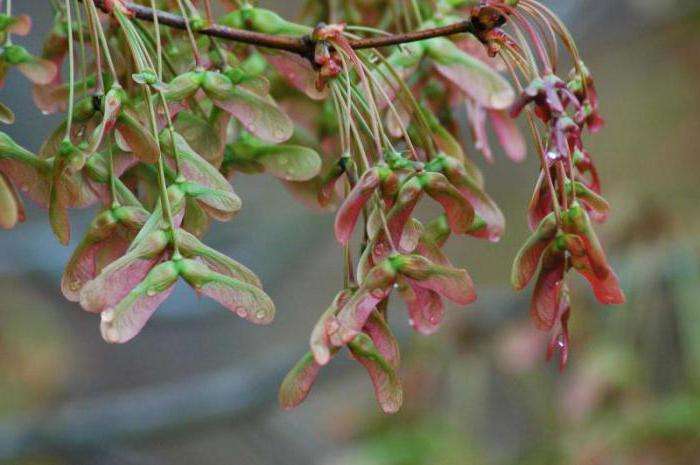

Maple seeds can also be planted outdoors in the fall; the most successful period is as close as possible to the time when the snow cover appears. In this case, the planting material is in natural conditions and begins to germinate in the spring. When planted during this period, the germination of seeds may be slightly lower due to severe frosts or a little snowy winter. However, the most common planting of maple seeds is done during this period.
How to care for cuttings
Care of developing cuttings consists in shading from the hot sun, in regular watering, in weeding, in loosening the soil; for the winter, young plants are spud and mulched (roses are additionally covered with leaves on top with a layer of 10-15 cm). With the establishment of a temperature of 0 + 2 degrees, a reliable frame is placed over the rooted conifers and roses and covered with a film; with a further decrease in temperature to minus 3-5 degrees, leaves or sawdust are poured onto the film with a layer of 5-7 cm and another layer of film is placed on top. In the spring, as the snow melts, the shelter is gradually removed and a covering material is pulled onto the frame over the plants to protect against sunburn. Well-rooted cuttings of winter-hardy conifers and deciduous plants can winter without additional shelter - under natural snow cover.
Where to plant a tree?
When the maple seeds are ready for planting, you should decide on the place of growth of this wonderful tree.
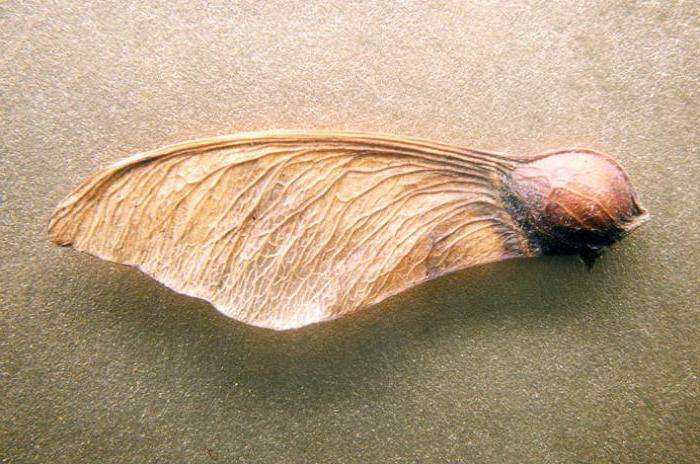

It is necessary to choose a sunny area; in its absence, some shading is permissible. The soil is recommended fertile and loose. Before planting, the soil should be dug up, in parallel fertilized with a mixture of sand, peat and humus.
Landing features
It is required to plant maple seeds 3-4 cm deep with the wings up. If in the future the transplantation of young plants is not planned, then the distance between the trees should be maintained at least 2 meters. The emergence of seedlings occurs in 2-3 weeks from the moment of planting. It is worth knowing that maple grows at a slow pace: by autumn, the height of young trees usually reaches 20-40 cm, and in the first year of growth, this figure reaches 80 cm. Caring for young trees is simple and consists in timely watering, regular weeding and getting rid of the plant from weeds. On hot days, it is recommended to shade young trees from direct sunlight.
Depending on their size, young maple trees can be planted in a regular growing area after 1-3 years. Planting should be carried out in pits dug in advance with a depth of about 70 cm, the width should be at least half a meter. If the groundwater is near the soil surface, the bottom of the pit should be covered with a 15-centimeter layer of sand or expanded clay.
Maple pests and diseases, methods of dealing with them
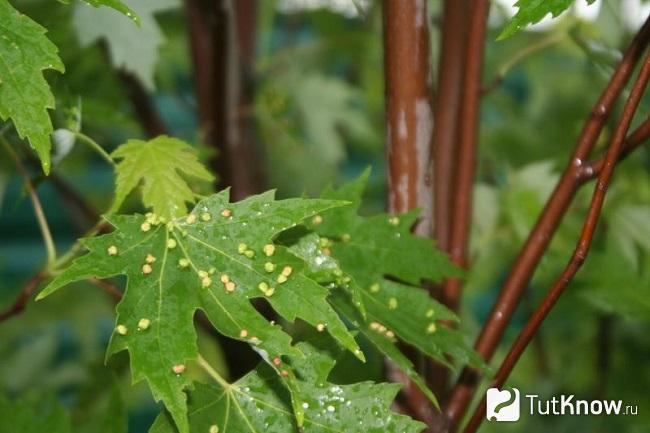

Maple often suffers from many infectious and fungal diseases, among which are powdery mildew, white, brown, pinkish, yellowish and black spot, blackening, wilt disease, viral mosaic or foliage becomes deformed. If these diseases are detected, treatment with fungicides, Bordeaux liquid should be carried out, colloidal sulfur or copper oxychloride should be used.
Pests can also cause irreparable harm to the maple tree by devouring foliage or sucking sap, and they are often carriers of infections with various ailments. Of the harmful insects, the American white butterfly, ash cape, and gypsy moth are distinguished. Maple lancet, apple scabbard, maple sawfly, and sycamore moth also cause harm to maples. In the fight against these insects, insecticidal preparations of a wide spectrum of action are used.
Often, trees are eaten by mice or hares and other animals.
Maple seeds in folk medicine
Maple seeds, photos of which are presented in the article, are effectively used in traditional medicine.
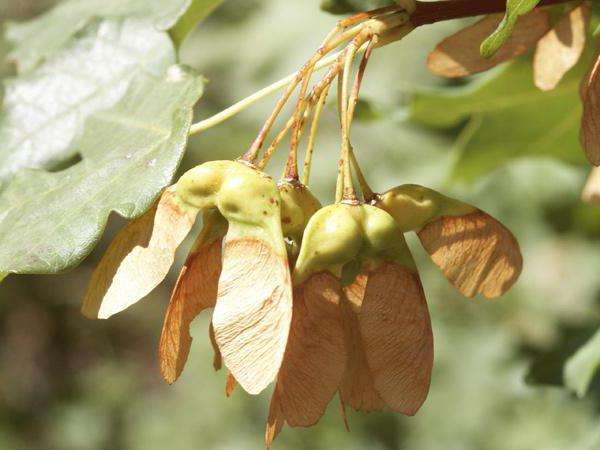

So, with colic and kidney disease, a decoction will help, for the preparation of which you need to pour a glass of boiling water, then insist in a water bath for about 40 minutes a mixture of a teaspoon of seeds and two tablespoons of chopped leaves. Strain the composition and take 4 times a day, 50 grams.
Treat herpes and bronchitis with an infusion of maple seeds, a teaspoon of which needs to be poured with a glass of boiling water and let it brew for 30-40 minutes. Consume 50 grams before meals 4 times a day.
Planting a maple tree from seed is a long-term and worthwhile investment in the future of your own garden. Several generations of descendants will rest under the shade of this gorgeous tree.
Home comfort How to grow moss at home: tips, subtleties, secrets
Not everyone likes to tinker with houseplants. Not everyone has a talent for this, and the flowers perish without having time to settle down. However, without greenery, window sills look lonely, and the interior is boring. And if you share this t ...
Home comfort Mold on bread. How to grow it at home?
Very often, biology departments in universities (and in a regular school as well) are asked a very unusual homework assignment - to grow mold on bread. And this is not done for fun. And for effective learning teaches ...
Food & Beverage How to sprout flax seeds for home meals and how to use them correctly?
Flax is one of the most ancient cultures that people began to cultivate. It is an excellent food product, a source of vitamins and antioxidants. The composition of flaxseeds contains a complex of vitamins, biologically ac ...
Business Breeding chinchillas as a business: at home growing, keeping, breeding
Our planet has long been inhabited by thousands of species of living beings and plants, many of which have not yet been studied or poorly studied. The species that have gained particular popularity among humans are listed in the Red Book. How…
Home and family Water hardness. How to determine water hardness at home? Methods, recommendations and feedback
On TV every now and then there are messages about the properties of hard water and its dangers not only for household appliances, but also for the body as a whole. What kind of water is this and why is it called hard? If you hit the scientific facts and p ...
Home comfort How do you get transparent ice? How to make clear ice at home?
At first glance, a banal situation: you approach a friend or relative and ask: “We need transparent ice. How to make the cubes not cloudy and in cracks, and even without a specific smell ...
Home comfort Hoya (flower): how to care at home, features of transplantation and recommendations
Hoya is a beautifully flowering wax ivy, which is an evergreen liana belonging to the Grimaceae family. This flower, numbering about two hundred species, is named after the British gardener T ...
Home comfort How to make an air freshener without essential oils from perfume at home? How to make an essential oil air freshener at home?
Cleanliness and freshness are the key to a favorable atmosphere in the house. And if with the first point everything is more or less clear (everyone knows that it is necessary to regularly clean up in your own home), then with the second everything is a lot ...
Planting maple seeds at home
Home comfort Gloxinia: how to care at home?
Bright and colorful, this flower adorns any interior and is a favorite of most housewives. Is gloxinia capricious? How to care for it so that it blooms willingly? Such nuances excite all newly minted gardeners ...
Home comfort How to make a fountain at home? DIY decorative indoor fountain
In specialized stores today you can buy very original indoor fountains. The assortment of such goods is large enough, as they say, for every taste and color. Many people like it when they hear the sound in the house ...
Maples can be propagated for introduction into forest, landscaping and protective belts by seeds, and for some species vegetatively (by growth from a stump), layering, root suckers.
Seedlings are often damaged by frost. The first and main requirement for the breeding of maples is the use for this purpose of planting material of local origin from species growing in these conditions or well acclimatized in them.
In order to facilitate the natural renewal of maples under the forest canopy, it is necessary, due to the rather high photopathy of many species, to clarify self-seeding and undergrowth by thinning the undergrowth, pruning the branches of trees in the upper tiers. In shading conditions in species such as ash-leaved maple, Ginnala, Semenova, alpine, the emerging self-seeding turns into a depressed state in the form of sticks and dies at the age of 5-10 years. Good results are obtained by caring for plantings by loosening the soil and thinning the seedlings. It is also necessary to take care of the maple shoots with the help of its gradual thinning and leaving shoots. Simultaneous thinning of the growth leads to negative results due to the dying off of the parent root system. When growing light-loving maple species, you should avoid planting them under the canopy of such shady species as spruce and beech.Under these conditions, maples should be grown in groups, in clumps in glades, glades and other illuminated places. Breeding and cultivation methods for many maple species introduced from other natural areas are still poorly developed due to the large number of species and form diversity of representatives of this genus.
Seeds for sowing in forest nurseries and on silvicultural areas of such maples as sycamore, holly, Ginnala, Tatar, field and ash-leaved, it is recommended to collect from the best standing trees in the phase of full maturity. When collecting lionfish, bunches of seeds should be removed from the tree using a ladder, the lionfish are broken off by hand or cut with pruners, loppers. The lionfish of these types of maple begin to fall off mostly in the second half of October (sometimes in late September - early October), and they can be collected from the ground by shaking them off on bedded canopy or on a previously cleared area.
Norway maple bears fruit almost every year, but abundant harvests occur in 3-4 years. In a productive year, up to 5-6 kg of fruit can be harvested from one free-standing tree. With an average yield, 160 kg of fruits can be harvested from 1 hectare of plantings of the III bonitet.
Maple bonsai - growing a miniature tree from seed
One worker collects about 6 to 8-10 kg during the day. Approximately 40-50 kg of fruits are processed in 1 day.
The fall of maple seeds often continues throughout the winter; lionfish hang on the tree sometimes until late March - early May. Fruits are cleaned by hand from stalks, small branches, leaves and other impurities or on a screen and grates.
After collecting the lionfish, it is necessary to immediately dry it, spreading it out in a layer of 5-10 cm, and after drying, sow it as soon as possible (silver maple, red). If sowing is not done in the fall, then the seeds are stored in bags, in a cool place (in the basement), or they are stratified. Storing damp seed should be avoided as it deteriorates very quickly. It is recommended to bring the moisture content of the seeds of these maples to 10-12%. Store in accordance with GOST.
To reduce the volume of seeds and the convenience of sowing them, the fruits can be de-winged on seed-cleaning machines or agricultural threshers, followed by sifting. For dewing, cleaning and sorting maple seeds, a universal seed-cleaning machine SUM-1 (by F.I.Sergeenko) or a MOS-1 machine and a winnower for forest seeds BLS-2, etc. are used.
Tray dryers manufactured by VNIILM and used by organizations of the Sortsemovosch association for drying vegetable and flower seeds are most suitable for drying a batch of up to 100-200 kg.
Maple seeds are characterized by different periods of dormancy before germination. According to the duration of dormancy, maple seeds can be divided into three groups (Aksenova, 1975). The first group includes seeds that do not have a dormant period. In silver maple, they germinate on the 3rd day after subsidence in moist soil. If their water content drops to 30-34%, then they lose their viability. The second group includes seeds of ash-leaved, red and other maples with a shallow dormancy period. They lose their germination after 2-5 months and germinate in moist soil on the 8-15th day. The third group includes seeds of many types of maple, which, when stored in a dry state, can remain viable for 2-3 years with an average soil germination rate of 70-78%.
Rapid germination of seeds in these species is impeded by dense and poorly water-permeable tissues of the pericarp, while in other species the delay in germination is explained by the state of the embryo, for the end of maturation of which a more or less prolonged effect of low temperatures is necessary. In Norway maples, Tatar, Gnnal, Semyonov, pseudosiboldov, yellow, green-horned, bearded, seeds remain viable for 2 years, and in pseudoplatan maple - less than a year.A long dormant period for maple seeds protects them from premature germination in autumn and freezing in winter.
Successful propagation of maples from seeds requires their stratification. Under natural conditions, seeds of fallen maples undergo stratification in winter, being in litter, and germinate in spring. Where there is no possibility of immediate sowing or cool and dry storage of seeds after harvest, they in most maple species should be stratified or appropriately processed, since after full ripening in autumn, the seeds need so-called ripening, lasting several months, to transform nutrients and the embryo achieves the necessary germination ability.
L.I. Rastorguev (I960) recommends the following periods of seed stratification: for Norway maple - 110 days, Tatar - 100, green-horned - 120, Manchurian - 100, bearded - 160, Ginnala - 110, spiky - 130, ash-leaved - 40 days. Many leshozes stratify maple seeds in ditches, in which a layer of 15-20 cm thick is interspersed with the same layers of dry soil and snow. To stimulate seed germination, various methods of chemical and physical action with gibberellic acid, hydrogen peroxide, wounding the dense membrane of the pericarp, and soaking the seeds before sowing for 24-72 hours are used.
Naked maple seeds are sown in beds in the middle zone of the Soviet Union in late April - early May in lines or scattering from 4-6 to 10 g per 1 linear meter. m with embedding to a depth of 3-4 cm. Autumn sowing of seeds provides earlier shoots compared to spring sowing. In most maple species, seeds germinate within 15-20 days. They are characterized by the above-ground type of germination. Initially, a hypocotyl emerges with an embryonic root, then a pair of cotyledons unfolds in the form of fleshy oval-oblong green formations. They persist in seedlings from 20 to 60 days and die off after the appearance of the first pair of leaves. In the first year of life, seedlings reach a height of 40-80 cm. They form a rod-type root, and subsequently branching lateral roots grow. Seedlings of many maple species can be damaged by spring frosts and need shelter. Aboriginal maple species are less sensitive to frost.
Seedling care consists of weeding, loosening and watering. In hot and sunny periods of the growing season, it is necessary to shade the emerging seedlings with shields. Transplants to schools and to permanent places of maple seedlings can be done at one and two years of age. The use of mineral fertilizers promotes almost 2-3 times better growth and development of seedlings. For podzolic soils, it is recommended to apply 100 kg of superphosphate, 75 kg of potassium chloride, 200 kg of ammonium nitrate per 1 ha.
For transplantation to a permanent place, the grown maple seedlings are sorted into two groups. According to GOST, I grade includes plants with a stem length of at least 10 cm, the height should be no more than 60 cm, the length of the root system 22-25 cm, the thickness of the root collar 4-12 mm, and in the II grade these indicators decrease: 10-30 cm, 18-20 cm, 3-5 mm.
When creating forest crops and protective forest belts, maple seedlings are introduced in clean rows. When creating 5-row forest shelter belts from oak, maple is planted in the edge rows, and when creating adjacent and coastal strips, in the edge and middle rows. Planting is carried out in parallel rows with a row spacing of 2.5-3.0 m, and in the south - 3-4 m with distances in rows between plants when planting seedlings from 1 to 1.5 m. Seedlings are planted with a single-row forest mounted planter SLN-1 or two-row SLN-2, planter of seedlings SSN-1.
Soil care in the aisles is carried out with a cultivator with a mounted plant feeder KRN-2.8A, and in rows with a cultivator KRL-1, in addition, a lateral forest cultivator KBL-1 is used to loosen the soil and destroy weeds in rows and protective forest crops up to 1 5-2.0 m.
As a result of production experiments, scientific research, taking into account the natural historical characteristics when growing protective forest plantations on the lands of agricultural enterprises, in the fight against water and wind erosion, it is recommended to introduce maple as an accompanying species.
In the regions of Ukraine and Moldova, on gray forest, podzolized, leached soils and typical chernozems, it is possible to grow Norway maples, field and sycamore.
On ordinary and southern chernozems - holly and field, on dark chestnut and chestnut soils - field maple. In the mountainous and foothill zones of the Crimea and the Carpathians - field and holly maples.
In the central chernozem zone and areas of the right bank of the Volga on gray forest, podzolized, leached and typical chernozems, Norway and Norway maples are recommended; on ordinary and southern chernozem, the maxi is holly. For the North Caucasus, on typical ordinary and southern chernozems, Norway maples, field maples, sycamore are suitable, and on dark chestnut soils, field and holly maples. In the Trans-Volga region, on podzolized leached, typical, ordinary and southern chernozems, there is Norway maple.
In the areas of the Right Bank of the Lower Volga, on dark chestnut soils and irrigated areas, Norway maples, field maples, and ash-leaved maples should be planted without irrigation; on light chestnut soils - ash-leaved; in the Caspian lowland on light chestnut soils - also ash-leaved maple; in Western and Eastern! Siberia, Northern and Central Kazakhstan on light and dark chestnut soils and leached chernozems - ash-leaved maple.
In Central Asia, on piedmont sierozem soils, Norway maples, field maples, Semyonov are recommended; in mountainous areas - Turkmen maple. In Azerbaijan, in mountainous areas on brown and mountain chernozems - field and high-mountain maples; in Armenia, Eastern Georgians in the lowlands up to 500 m above sea level. m., chestnut and light chestnut soils - high-mountain maples, Georgian and field maples.
In mountainous areas on brown soils, leached chernozems, alpine and field maples are recommended; in Western Georgia on the foothills - field maple.
As part of forest crops in the European part of the USSR, Norway maples, field maples, Tatar maples, and silver maples were planted on the plain; in the mountainous and foothill zones of the Crimea and the Carpathians - field, holly; in the North Caucasus - holly, sycamore, field, etc.; in Srednyaya Azin - holly, field, Semyonov; in the mountainous regions in Armenia, Eastern Georgia - alpine, Georgian and field.
Cuttings for planting maintenance are carried out during three periods of planting development. The first at the age of 7-10 years (before the crown closes), the second - 10-40 years (formation of the necessary structure), the third - 16-41 years and older (maintaining the necessary structure and viability). Trimming of the lower branches with a diameter of up to 3 cm is done with a pneumatic pruner SP-2 on a PAV-8 unit, and with a diameter of up to 8 cm - with an ax, hand hacksaws. For continuous and selective removal of trees with a diameter of stumps over 8 cm, use the Druzhba (Ural) chainsaw; for selective removal of trees with a diameter of up to 8 cm, use the Secor ax, the Druzhba chainsaw with the SK-1 attachment, and with continuous - existing brush cutters and bulldozers. Cutting for the regeneration of maple trees in the steppe zone should be carried out at the age of declining growth and the appearance of dry branches in the crowns (25-30 years).
For the prospect of growing introduced maple species in the USSR, the most difficult and still poorly studied problem is the development of methods for breeding more frost-resistant forms. For the middle zone of the taiga zone of the USSR, when growing maples, it is necessary to distinguish between their winter hardiness and frost resistance. The majority of maples are winter-hardy, with the exception of the palmate, curled.Maples are weakly frost-resistant, which can withstand average cold winters, but are damaged and even freeze up, renewing undergrowth at lower negative temperatures (below -25 ° C). These include individual forms of Norway maples, pseudoplatanus, majestic maples, as well as green-barked, red, yellow maples, etc. Research on increasing the frost resistance of maples should be accompanied by the study of their shape diversity.
If you find an error, please select a piece of text and press Ctrl + Enter.
Growing maple from seeds.
Among ornamental trees, maple has long been one of the most honorable places. This beautiful tall tree is loved by many primarily because of the amazing carved leaves, which are repeatedly sung by poets, captured by painters, and the characteristic shape of the maple leaf proudly adorns the national flag of Canada. Maple is especially beautiful in autumn, when its foliage reads to play with a whole range of yellow and burgundy shades. The variety of maple species is great and allows you to choose a suitable specimen even for a small garden plot. It is especially pleasant when such a tree is grown from seeds with your own hands, which, by the way, is not at all difficult to do even for a beginner.
The first step is to decide what kind of maple to grow. The fact is that not all maples can be grown from seeds - some decorative forms propagate by cuttings or by grafting. Tatar maple, Ginnala, holly and green-barked maple are best suited for growing from seeds.
In their natural environment, maple seeds fall off in autumn, and begin to germinate in spring. In accordance with this natural rhythm, you need to act in order to get the desired result. For this, the seeds collected in the fall or acquired during the same period must be stratified. The essence of this process is to simulate a period of winter dormancy under artificial conditions, after which plants in nature begin to grow rapidly. To do this, the seeds must be kept in the cold for 100 - 120 days at an air temperature of +3 - 5 ° C. The most suitable place would be a refrigerator or a cold room where the temperature is kept within these limits. It is recommended to store the seeds in a small container filled with wet sand. In the spring - in April or early May - it is time to plant seeds for germination. Planting is carried out directly into the open ground.
Varieties
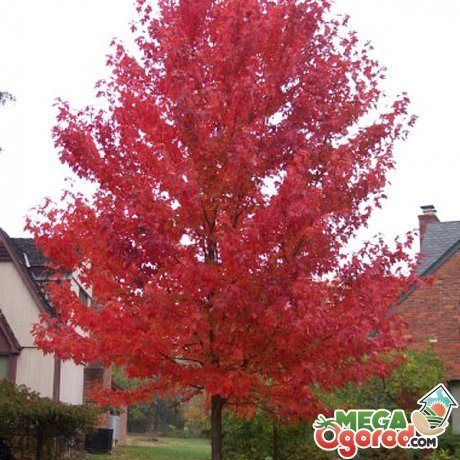

The best varieties to grow:
- Field maple "Elsric". It is a perennial deciduous tree with a height of 5-8 meters. The crown is dense, dense, oval in shape, its width reaches 3-5 meters in diameter. The leaves are large, carved, and consist of 5 lobes. Appear in April or early May and are reddish in spring. In the sun in the summer months, the leaves acquire a yellow color, in the shade they are green. By autumn, all the foliage becomes a rich yellow tone. The buds are collected in corymbose inflorescences, the petals are painted in a yellowish-green tone. The fruits are lionfish, appear at the end of summer, by autumn they acquire a nondescript brown tint. This variety of field maple has a high decorative value due to the seasonal color of the leaves. The tree is resistant to powdery mildew, tolerates drought well and is suitable for planting on city streets.
- Field maple "RedShine". It is a small tree with a height of only 5 meters. It has a rounded spreading crown, a medium-sized trunk with a grayish bark. The leaves are large, lobed, painted in a purple-red tone. In the spring, it blooms in a nondescript greenish-yellow tone. The buds are collected in small inflorescences.
- Field maple "Albovariegatum". This variety is a small shrub that reaches a height of 5 meters. Often used as hedges. The trunks are strong, branching begins from the bottom.The bark is gray, with small longitudinal cracks. The leaves are large, lobed, painted in white-green, variegated tone. In the autumn, they turn yellow.
How to grow maple from seeds at home tips
To speed up the emergence of sprouts, you should first soak maple seeds in hydrogen peroxide for 1 to 3 days. Now they are ready to plant and they have to choose a place where this wonderful tree will grow.
The area where the maple will grow should be sunny or slightly shaded. The soil is preferable fertile and loose, therefore it is advisable to dig up the soil before planting and make it fine-grained and homogeneous. It is recommended to add some peat, humus and sand to the garden soil.
Seeds are planted to a depth of 3 - 4 cm.If the seedlings are not planned to be transplanted in the future, then the interval between plants of 1.5 - 2 m should be observed immediately.But it is better to plant the seeds at a closer distance - then they can be thinned out and later the best seedlings can be planted to permanent places. The planted seeds need to be watered and further maintain the soil in a slightly damp state.
The onset of seedling emergence should be expected 2 to 3 weeks after planting. It should be borne in mind that maple germinates rather slowly, but after the seeds have sprouted, caring for them is quite simple: regular watering, gentle weeding and weeding. On hot summer days, it is advisable to shade young plants from direct sunlight. By autumn, the height of seedlings reaches 20 - 40 cm, and in the first year of life they can grow up to 80 cm.
Another method of growing maple from seeds is also practiced, in which they are planted in open ground in the fall. In this case, the planting material is in its natural habitat throughout the winter and begins to germinate in the spring. When planting in this way, seed germination will be slightly lower due to severe frosts or snowless winter. However, this method is the most natural and is often used when growing this plant.
After 1 - 3 years, depending on the size of the seedlings, they can be planted in a permanent place. Planting is carried out in pre-dug holes with a depth of 70 cm and a side width of 50 cm. The composition of the soil should be approximately the same as for germinating seeds. It is recommended to add organic fertilizer such as compost or humus to the soil before planting. In the future, it is advisable to apply complex fertilizer for perennial plants every summer.
If the groundwater at the site is quite close to the surface, then a layer of sand or expanded clay with a thickness of about 15 cm should be laid at the bottom of the planting pit - this will noticeably improve the outflow of excess moisture. At the bottom of the pit, soil is poured in the form of a slide, on which the seedling is "seated" and its roots are straightened. Then they cover it with earth so that the root collar is no deeper than 5 cm underground.
Maple is a beautiful and easy-care tree that has positive energy. In summer, in the shade of its dense crown, you can have a great rest, and with the arrival of autumn, you can enjoy the beauty of the yellowing foliage. Without a doubt, planting a maple tree is a long-term investment in the future of your garden, which more than one generation of descendants will enjoy.
More information on the topic:
How to prepare a cutting
For each species of woody plants, it is important to establish the most favorable propagation period by cuttings, which is determined by the calendar period and the degree of lignification (young shoots easily rot, their immature tissue is not able to form roots). In the middle zone of the European part of the former USSR, the period from late May to early July is considered optimal for rooting of green cuttings of deciduous species. At the early stages of this period, rooting is better, moreover, for cutting the cuttings, the entire shoot is used, in which the lower part is semi-lignified, and the upper part is green.In the later periods of this period, when the deciduous breed finishes growing, almost a third of the shoot prepared for cuttings is not used.
The best terms for green cuttings of varietal lilacs and chubushniks are at the time of flowering (you should not cut cuttings from shoots with flowers or flower buds), and in a number of other types and forms of deciduous trees - during the period of intensive shoot growth. Summer cuttings in a greenhouse with strong lateral shoots of the mother plant "with a heel" or apical cuttings are recommended for barberry, euonymus, buddlea, weigela, wolf, hydrangea, honeysuckle, cinquefoil, viburnum, cotoneaster, broom, rhododendron, etc. rare plants in a cold greenhouse, which is much more difficult than autumn cuttings in the open field.
Conifers are cut either in spring, before the buds swell (for example, shoots of thuja western, spruce, fir and junipers are harvested from late April to early May) or in summer, when they finish active growth (from mid-June to mid-July). Most conifers and maples, oak, linden, birch, and other trees are difficult to root during cuttings (their callus often reaches large sizes, greatly depletes the cutting and prevents root formation). Shoots of the current year are cut into cuttings when they are still flexible enough and the bark is green. In most woody plant species, cuttings are cut from the middle part of the shoot, discarding the too soft upper part and the too lignified lower part. When cutting a cutting from the upper part of a full-fledged shoot of deciduous and coniferous species (called the apical cutting), the apical bud is left on the cutting.


Cutting shoots into cuttings is best done early in the morning or on a cloudy day (to reduce evaporation from cuttings); large leaf blades are cut in half and the cut shoots are placed with the lower ends in a vessel with water... The length and thickness of the cuttings are important for successful root formation (very thin cuttings are undesirable). The length of the cutting is determined by the size of internodes: cuttings from shoots with short nodes are cut with 3-4 internodes, and from shoots with long nodes - with 2 internodes. Usually, the length of green cuttings ranges from 3 to 12 cm (longer cuttings take root less well), on average it is 8-10 cm.

